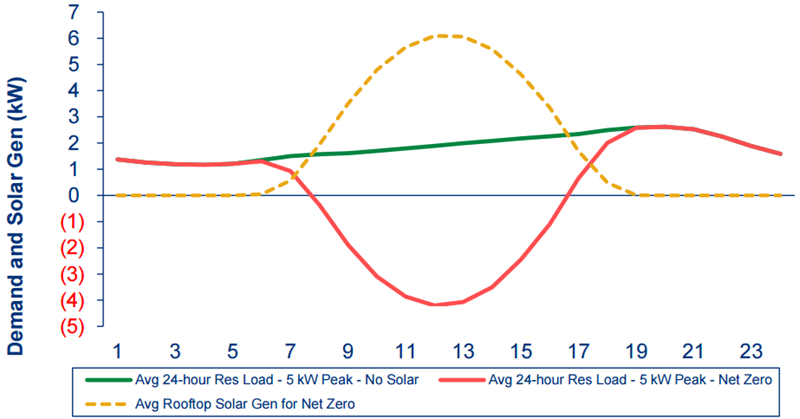Discuss your challenges with our solutions experts
Several states have recently restored or extended full retail Net Metering for residential rooftop solar. This again raises the vigorously debated issue of whether or not Net Metering is fair to both utility customers with rooftop solar and to customers without rooftop solar. Some policymakers are also advocating that new homes be "Net Zero", meaning that over the course of the year, the amount of energy produced by a home's solar panels needs to be at least equal to the home's electricity demand. Net Zero does not mean that the home never uses power from the utility, and it turns out that a Net Zero solar home is a good case study demonstrating that Net Metering does in fact credit solar homeowners at the expense of other ratepayers.
Based upon residential demand profile data from Southern California Edison and NREL solar production data for rooftop solar, we compared the hourly demand profiles of a home in Riverside California to the hourly demand profile of the same home with enough rooftop solar to displace its energy demand over the course of the year (Net Zero). The non-solar home in this example has a peak demand of 5 kW, and we determined it would require about an 8-kW south-facing rooftop solar system in order to be a Net Zero home.
The above chart shows the annual Load Duration Curves (LDC) of both the non-solar home and the Net Zero home. Notice that the non-solar home has an annual load factor (LF) of 37%, representing the ratio of average demand divided by the 5 kW peak demand. The chart also shows that the hourly peak demand for the Net Zero home is only about 12% lower than the non-solar home. This reflects the times during the summer when the Net Zero home is running its air conditioner after the sun goes down. During about 35% of the year, the Net Zero home will produce more solar energy than it consumes (when the red line is below zero), and send power back to the grid. The majority of the year the Net Zero home is consuming power from the grid.
The chart below shows how power consumption looks over a 24-hour day representing the average of all 365 days of the year. Because many days don't require air conditioning, the average daily peak load for the both the non-solar home and the Net Zero home is only about 2.6 kW. Although the Net Zero home's solar system produces much more energy than it uses during the middle of the day, the average peak hour occurs after the sun goes down. In other words, most days of the year, the solar system does nothing to reduce the home's daily peak demand.
The Net Metering dilemma should be apparent from the above charts based upon the fact that the load factor of the Net Zero home is zero. With a "net volume" of zero, any fixed costs of service (transmission, distribution, or generator capacity charges) cannot be recovered through volumetric rates — dividing by zero usage equals infinity. One alternative would be to recover these fixed costs using Demand Charges proportional to the "net peak" of the home. In the above example, the Demand Charges for a Net Zero home would at most only be about 12% lower compared to the non-solar home. This might incentivize battery storage, which would allow the solar home to store some of the surplus solar energy earlier in the day and use that in the evening to reduce Demand Charges.
When a power grid does not have much solar installed, a new solar home often provides more "energy value" to the grid than it consumes because solar production occurs during the day when wholesale power prices are the highest. However, over time, increasing levels of solar generation (both rooftop and utility-scale) reduces the system hourly net demand and suppresses energy prices. This has already occurred in California, where wholesale energy prices from 9 AM to 2 PM are frequently close to zero or even negative due to solar generation surpluses. As a result, it is an easy exercise to show that the value of the surplus energy produced by a Net Zero solar home in California is now less than the cost of energy the home consumes the rest of the year. The utility is then effectively acting as a battery that is paying more to charge than it receives when it generates. If the Net Zero home has no bill at the end of the year, then non-solar homes in California are subsidizing both the fixed costs attributable to the solar home and the negative net energy value of the solar home. This is not a sustainable situation with large amounts of rooftop solar additions expected to continue in California.
The California Public Utilities Commission has struggled to develop new utility rate designs deemed fair to both rooftop solar customers and non-solar customers, but eventually it must do so in the face of California's low-carbon energy policies. Otherwise, how will utilities pay to maintain the grid when every home has rooftop solar? Many other states are wrestling with these same issues. Rate design changes will directly influence the deployment levels of both customer-side solar and battery storage for years to come, with direct cost impacts for non-solar customers who rely on utilities for their electric service.







